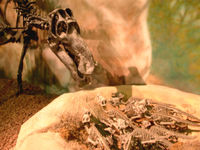Maiasaura
2008/9 Schools Wikipedia Selection. Related subjects: Dinosaurs
| Maiasaura Fossil range: Late Cretaceous |
||||||||||||||||||||
|---|---|---|---|---|---|---|---|---|---|---|---|---|---|---|---|---|---|---|---|---|
 Maiasaura with hatchlings, at the Wyoming Dinosaur Centre
|
||||||||||||||||||||
| Conservation status | ||||||||||||||||||||
|
Fossil
|
||||||||||||||||||||
| Scientific classification | ||||||||||||||||||||
|
||||||||||||||||||||
| Binomial name | ||||||||||||||||||||
| Maiasaura peeblesorum Horner & Makela, 1979 |
Maiasaura (meaning "good mother lizard") is a large duck-billed dinosaur genus that lived in the area currently covered by the state of Montana in the Upper Cretaceous Period ( Campanian), about 74 million years ago. It is hitherto only known from the upper Two Medicine Formation.
Discovery
Maiasaura was discovered by dinosaur paleontologist Jack Horner (paleontologic advisor for the Jurassic Park movies) and Robert Makela. He named the dinosaur after finding a series of nests with remains of eggshells and hatchlings at "Egg Mountain", in rocks of the Two Medicine Formation near Choteau in western Montana. This was the first proof of giant dinosaurs raising and feeding their young. Over 200 specimens, in all age ranges, have been found.
Characteristics

Maiasaura was large (about 7 meters long) and had the typical hadrosaurid flat beak and a thick nose. It had a small, spiky crest in front of its eyes. The form of the head resembled that of a horse.
This dinosaur was herbivorous. It walked both on two ( bipedal) or four ( quadrupedal) legs and appeared to have no defense against predators, except, perhaps, its heavy muscular tail and its herd behaviour. These herds were extremely large and could have comprised as many as 10,000 individuals.
Reproduction
Maiasaura lived in herds and it raised its young in nesting colonies. The nests, contained 30 to 40 eggs laid in a circular or spiral pattern. They were made of earth. The eggs were about the size of ostrich eggs.
The eggs were hatched by the heat resulting from rotting vegetation placed into the nest by the parents, rather than a parent sitting on the nest. Upon hatching, fossils of baby Maiasaura show that their legs were not fully developed and thus they were incapable of walking. Fossils also show that their teeth were partly worn, which means that the adults had to bring food to the nest.
The hatchlings grew from a size of 16 inches to 58 inches long in the span of their first year. At this point, or perhaps after another year, the animal left the nest. The hatchlings had different facial proportions from the adults, with larger eyes and a shorter snout.
Contemporaries
Maiasaura lived alongside Orodromeus, Troodon, the ceratopsid Centrosaurus, the tank-like Euoplocephalus and earlier relatives of Tyrannosaurus rex, Daspletosaurus torosus and Albertosaurus. It was among the latest dinosaur species to evolve, prior to the Cretaceous-Tertiary extinction of 65 million years ago.
Related Animals
- Brachylophosaurus
More Distant Relatives
- Hadrosaurus
- Aralosaurus
- Gryposaurus

